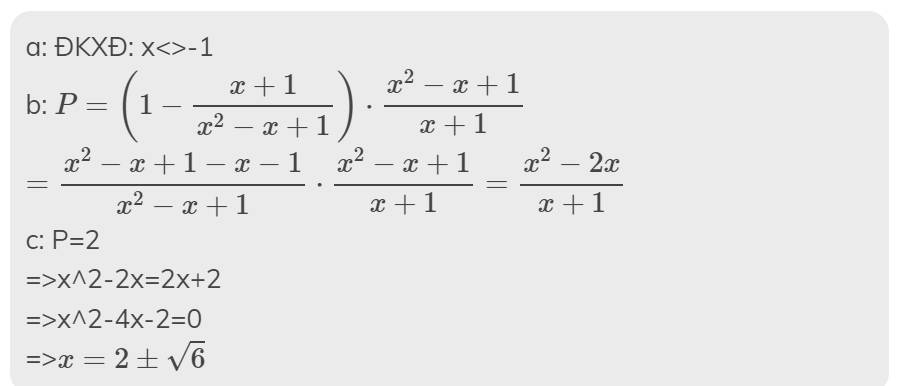Cho P = \(\dfrac{x^4-x}{x^2+x+1}-\dfrac{2x^2+x}{x}+\dfrac{2\left(x^2-1\right)}{x-1}\)
a) Rút gọn P
b) Tìm GTNN của P
c) Tìm các giá trị dương của x để Q= \(\dfrac{2x}{p}\) nhận giá trị là số nguyên
HELP ME ..

Những câu hỏi liên quan
Bài 1: Cho Pdfrac{1}{x+5}+dfrac{2}{x-5}-dfrac{2x+10}{left(x+5right)left(x-5right)} a) Tìm điều kiện xác định của P b) Rút gọn P c) Tìm x để P-3 d) Tìm các giá trị nguyên của x để P nhận giá trị nguyênBài 2: Tìm x để các phân thức sau có giá trị bằng 0 a)dfrac{3x^2+6x+12}{x^3-8} b)dfrac{2x-x^2}{x^2-4}
Đọc tiếp
Bài 1: Cho P=\(\dfrac{1}{x+5}\)+\(\dfrac{2}{x-5}-\dfrac{2x+10}{\left(x+5\right)\left(x-5\right)}\)
a) Tìm điều kiện xác định của P
b) Rút gọn P
c) Tìm x để P=-3
d) Tìm các giá trị nguyên của x để P nhận giá trị nguyên
Bài 2: Tìm x để các phân thức sau có giá trị bằng 0
a)\(\dfrac{3x^2+6x+12}{x^3-8}\) b)\(\dfrac{2x-x^2}{x^2-4}\)
Bài 1:
\(a,ĐK:x\ne\pm5\\ b,P=\dfrac{x-5+2x+10-2x-10}{\left(x-5\right)\left(x+5\right)}=\dfrac{x-5}{\left(x-5\right)\left(x+5\right)}=\dfrac{1}{x+5}\\ c,P=-3\Leftrightarrow x+5=-\dfrac{1}{3}\Leftrightarrow x=-\dfrac{16}{3}\\ d,P\in Z\Leftrightarrow x+5\inƯ\left(1\right)=\left\{-1;1\right\}\\ \Leftrightarrow x\in\left\{-6;-4\right\}\)
Bài 2:
\(a,\Leftrightarrow\dfrac{3\left(x^2+2x+4\right)}{\left(x-2\right)\left(x^2+2x+4\right)}=\dfrac{3}{x-2}=0\Leftrightarrow x\in\varnothing\\ b,\Leftrightarrow\dfrac{x\left(2-x\right)}{\left(x-2\right)\left(x+2\right)}=0\Leftrightarrow\dfrac{-x}{x+2}=0\Leftrightarrow x=0\)
Đúng 2
Bình luận (0)
P = \(\left(1-\dfrac{x^2+2x+1}{x^3+1}\right)\)\(:\dfrac{x^2+2x+1}{x^3+1}\)
a)Tìm điều kiện của x để biểu thức P xác định
b)Rút gọn biểu thức P
c)Với giá trị nào của x thì P = 2
d)Tìm các giá trị nguyên của x để P nhận giá trị nguyên
a: ĐKXĐ: x<>-1
b: \(P=\left(1-\dfrac{x+1}{x^2-x+1}\right)\cdot\dfrac{x^2-x+1}{x+1}\)
\(=\dfrac{x^2-x+1-x-1}{x^2-x+1}\cdot\dfrac{x^2-x+1}{x+1}=\dfrac{x^2-2x}{x+1}\)
c: P=2
=>x^2-2x=2x+2
=>x^2-4x-2=0
=>\(x=2\pm\sqrt{6}\)
Đúng 0
Bình luận (0)
Rút gọn
\(C=\dfrac{x^2-\sqrt{x}}{x+\sqrt{x}+1}-\dfrac{2x+\sqrt{x}}{\sqrt{x}}+\dfrac{2\left(x-1\right)}{\sqrt{x}-1}\) với \(x>0,x\ne1\)
- tìm GTNN của C
- tìm x để N= \(\dfrac{2\sqrt{x}}{C}\) nhận giá trị nguyên
*Rút gọn
Ta có: \(C=\dfrac{x^2-\sqrt{x}}{x+\sqrt{x}+1}-\dfrac{2x+\sqrt{x}}{\sqrt{x}}+\dfrac{2\left(x-1\right)}{\sqrt{x}-1}\)
\(=\dfrac{\sqrt{x}\left(\sqrt{x}-1\right)\left(x+\sqrt{x}+1\right)}{x+\sqrt{x}+1}-\dfrac{\sqrt{x}\left(2\sqrt{x}+1\right)}{\sqrt{x}}+\dfrac{2\left(\sqrt{x}+1\right)\left(\sqrt{x}-1\right)}{\sqrt{x}-1}\)
\(=x-\sqrt{x}-2\sqrt{x}-1+2\sqrt{x}+2\)
\(=x-\sqrt{x}+1\)
Ta có: \(C=x-\sqrt{x}+1\)
\(=x-2\cdot\sqrt{x}\cdot\dfrac{1}{2}+\dfrac{1}{4}+\dfrac{3}{4}\)
\(=\left(\sqrt{x}-\dfrac{1}{2}\right)^2+\dfrac{3}{4}\ge\dfrac{3}{4}\forall x\) thỏa mãn ĐKXĐ
Dấu '=' xảy ra khi \(\sqrt{x}=\dfrac{1}{2}\)
hay \(x=\dfrac{1}{4}\)
Đúng 1
Bình luận (0)
\(C=\dfrac{x^2-\sqrt{x}}{x+\sqrt{x}+1}-\dfrac{2x+\sqrt{x}}{\sqrt{x}}+\dfrac{2\left(x-1\right)}{\sqrt{x}-1}\left(x>0;x\ne1\right)\)
\(=\dfrac{\sqrt{x}\left(\sqrt{x}-1\right)\left(x+\sqrt{x}+1\right)}{x+\sqrt{x}+1}-\dfrac{\sqrt{x}\left(2\sqrt{x}+1\right)}{\sqrt{x}}+\dfrac{2\left(\sqrt{x}-1\right)\left(\sqrt{x}+1\right)}{\sqrt{x}-1}\)
\(=\sqrt{x}\left(\sqrt{x}-1\right)-2\sqrt{x}-1+2\sqrt{x}+2\)
\(=x-\sqrt{x}+1\)
\(=\left(\sqrt{x}-\dfrac{1}{2}\right)^2+\dfrac{3}{4}\ge\dfrac{3}{4}\)
Dấu "=" xảy ra khi \(\sqrt{x}-\dfrac{1}{2}=0\Leftrightarrow x=\dfrac{1}{4}\)
Vậy \(C_{min}=\dfrac{3}{4}\)
\(N=\dfrac{2\sqrt{x}}{C}=\dfrac{2\sqrt{x}}{x-\sqrt{x}+1}=\dfrac{2}{\sqrt{x}+\dfrac{1}{\sqrt{x}}-1}\)
Áp dụng AM-GM có: \(\sqrt{x}+\dfrac{1}{\sqrt{x}}\ge2\)
Dấu "=" xảy ra khi x=1 (ktm đk)
Suy ra dấu bằng ko xảy ra \(\Rightarrow\sqrt{x}+\dfrac{1}{\sqrt{x}}-1>2-1=1\)
\(\Rightarrow\dfrac{2}{\sqrt{x}+\dfrac{1}{\sqrt{x}}-1}< 2\)
\(\Rightarrow N< 2\) mà \(N>0\),\(N\) nguyên
\(\Rightarrow N=1\Leftrightarrow\dfrac{2\sqrt{x}}{x-\sqrt{x}+1}=1\)\(\Leftrightarrow\left[{}\begin{matrix}\sqrt{x}=\dfrac{3+\sqrt{5}}{2}\\\sqrt{x}=\dfrac{3-\sqrt{5}}{2}\end{matrix}\right.\)\(\Leftrightarrow\left[{}\begin{matrix}x=\dfrac{7+3\sqrt{5}}{2}\\x=\dfrac{7-3\sqrt{5}}{2}\end{matrix}\right.\) (tm)
Vậy...
Đúng 3
Bình luận (0)
\(\Rightarrow C=\dfrac{\sqrt{x}\left(\sqrt{x}-1\right)\left(x+\sqrt{x}+1\right)}{x+\sqrt{x}+1}-\dfrac{\sqrt{x}\left(2\sqrt{x}+1\right)}{\sqrt{x}}+\dfrac{2\left(\sqrt{x}-1\right)\left(\sqrt{x}+1\right)}{\sqrt{x}-1}=x-\sqrt{x}-2\sqrt{x}-1+2\sqrt{x}+2=x-\sqrt{x}+1\) * \(\Rightarrow C=\left(\sqrt{x}-\dfrac{1}{2}\right)^2+\dfrac{3}{4}\ge\dfrac{3}{4}\) Dấu = xảy ra \(\Leftrightarrow x=\dfrac{1}{2}\)
* Ta có \(N=\dfrac{2\sqrt{x}}{C}=\dfrac{2\sqrt{x}}{x-\sqrt{x}+1}>0\left(1\right)\)
Xét \(N-2=\dfrac{2\sqrt{x}}{x-\sqrt{x}+1}-2=\dfrac{2\sqrt{x}-2x+2\sqrt{x}-2}{x-\sqrt{x}+1}=\dfrac{-2x+4\sqrt{x}-2}{x-\sqrt{x}+1}=\dfrac{-2\left(\sqrt{x}-1\right)^2}{x-\sqrt{x}+1}< 0\left(dox\ne1\right)\Rightarrow N< 2\left(2\right)\) Từ (1) và (2) \(\Rightarrow0< N< 2\). Mà N nguyên nên N=1 \(\Rightarrow\dfrac{2\sqrt{x}}{x-\sqrt{x}+1}=1\Rightarrow2\sqrt{x}=x-\sqrt{x}+1\Leftrightarrow x-3\sqrt{x}+1=0\)
\(\Delta=9-4=5\Rightarrow\) pt có 2 nghiệm phân biệt: \(x_1=\dfrac{\sqrt{5}+3}{2}\left(TM\right);x_2=\dfrac{3-\sqrt{5}}{2}\left(TM\right)\)
Đúng 1
Bình luận (1)
P = \(\left(1-\dfrac{x^2}{x^2-x+1}\right):\dfrac{x^2+2x+1}{x^3+1}\)
a)Tìm điều kiện của x để biểu thức P xác định
b)Rút gọn biểu thức P
c)Với giá trị nào của x thì P = 2
d)Tìm các giá trị nguyên của x để P nhận giá trị nguyên
Cho biểu thức Pleft(dfrac{2x}{x^3+x^2+x+1}+dfrac{1}{x+1}right):left(1+dfrac{x}{x+1}right)a) Rút gọn P b) Tính giá trị của P biết xdfrac{1}{4} c) Tìm GTNN của biểu thức dfrac{1}{P} giúp mk vs!!!!
Đọc tiếp
Cho biểu thức P=\(\left(\dfrac{2x}{x^3+x^2+x+1}+\dfrac{1}{x+1}\right):\left(1+\dfrac{x}{x+1}\right)\)
a) Rút gọn P
b) Tính giá trị của P biết \(x=\dfrac{1}{4}\)
c) Tìm GTNN của biểu thức \(\dfrac{1}{P}\)
giúp mk vs!!!!
ĐKXĐ: \(x\notin\left\{-1;-\dfrac{1}{2}\right\}\)
a) Ta có: \(P=\left(\dfrac{2x}{x^3+x^2+x+1}+\dfrac{1}{x+1}\right):\left(1+\dfrac{x}{x+1}\right)\)
\(=\left(\dfrac{2x}{\left(x+1\right)\left(x^2+1\right)}+\dfrac{x^2+1}{\left(x^2+1\right)\left(x+1\right)}\right):\left(\dfrac{x+1+x}{x+1}\right)\)
\(=\dfrac{x^2+2x+1}{\left(x+1\right)\left(x^2+1\right)}:\dfrac{2x+1}{x+1}\)
\(=\dfrac{\left(x+1\right)^2}{\left(x+1\right)\left(x^2+1\right)}\cdot\dfrac{x+1}{2x+1}\)
\(=\dfrac{x^2+2x+1}{\left(2x+1\right)\left(x^2+1\right)}\)
b) Vì \(x=\dfrac{1}{4}\) thỏa mãn ĐKXĐ
nên Thay \(x=\dfrac{1}{4}\) vào biểu thức \(P=\dfrac{x^2+2x+1}{\left(2x+1\right)\left(x^2+1\right)}\), ta được:
\(P=\left[\left(\dfrac{1}{4}\right)^2+2\cdot\dfrac{1}{4}+1\right]:\left[\left(2\cdot\dfrac{1}{4}+1\right)\left(\dfrac{1}{16}+1\right)\right]\)
\(=\left(\dfrac{1}{16}+\dfrac{1}{2}+1\right):\left[\left(\dfrac{1}{2}+1\right)\left(\dfrac{1}{16}+1\right)\right]\)
\(=\dfrac{25}{16}:\dfrac{51}{32}=\dfrac{25}{16}\cdot\dfrac{32}{51}=\dfrac{50}{51}\)
Vậy: Khi \(x=\dfrac{1}{4}\) thì \(P=\dfrac{50}{51}\)
Đúng 0
Bình luận (0)
Cho C =\(\left(\dfrac{1}{x-1}-\dfrac{2x}{x^3-x^2+x-1}\right):\left(\dfrac{x^2+2}{x^3+x^2+x+1}+\dfrac{1}{x+1}\right)\)
a) Tìm đkxđ của C
b) Rút gọn C
c) Tìm x để C =\(\dfrac{2}{5}\)
d) Tìm x ϵ Z để giá trị C là số nguyên
Bổ sung phần c và d luôn:
c, C = \(\dfrac{2}{5}\)
\(\Leftrightarrow\) \(\dfrac{x^2-1}{2x^2+3}\) = \(\dfrac{2}{5}\)
\(\Leftrightarrow\) 5(x2 - 1) = 2(2x2 + 3)
\(\Leftrightarrow\) 5x2 - 5 = 4x2 + 6
\(\Leftrightarrow\) x2 = 11
\(\Leftrightarrow\) x2 - 11 = 0
\(\Leftrightarrow\) (x - \(\sqrt{11}\))(x + \(\sqrt{11}\)) = 0
\(\Leftrightarrow\) \(\left[{}\begin{matrix}x-\sqrt{11}=0\\x+\sqrt{11}=0\end{matrix}\right.\)
\(\Leftrightarrow\) \(\left[{}\begin{matrix}x=\sqrt{11}\left(TM\right)\\x=-\sqrt{11}\left(TM\right)\end{matrix}\right.\)
d, Ta có: \(\dfrac{x^2-1}{2x^2+3}\) = \(\dfrac{x^2+\dfrac{3}{2}-\dfrac{5}{2}}{2\left(x^2+\dfrac{3}{2}\right)}\) = \(\dfrac{1}{2}\) - \(\dfrac{5}{4\left(x^2+\dfrac{3}{2}\right)}\)
C nguyên \(\Leftrightarrow\) \(\dfrac{5}{4\left(x^2+\dfrac{3}{2}\right)}\) nguyên \(\Leftrightarrow\) 5 \(⋮\) 4(x2 + \(\dfrac{3}{2}\))
\(\Leftrightarrow\) 4(x2 + \(\dfrac{3}{2}\)) \(\in\) Ư(5)
Xét các TH:
4(x2 + \(\dfrac{3}{2}\)) = 5 \(\Leftrightarrow\) x2 = \(\dfrac{-1}{4}\) \(\Leftrightarrow\) x2 + \(\dfrac{1}{4}\) = 0 (Vô nghiệm)
4(x2 + \(\dfrac{3}{2}\)) = -5 \(\Leftrightarrow\) x2 = \(\dfrac{-11}{4}\) \(\Leftrightarrow\) x2 + \(\dfrac{11}{4}\) = 0 (Vô nghiệm)
4(x2 + \(\dfrac{3}{2}\)) = 1 \(\Leftrightarrow\) x2 = \(\dfrac{-5}{4}\) \(\Leftrightarrow\) x2 + \(\dfrac{5}{4}\) = 0 (Vô nghiệm)
4(x2 + \(\dfrac{3}{2}\)) = -1 \(\Leftrightarrow\) x2 = \(\dfrac{-7}{4}\) \(\Leftrightarrow\) x2 + \(\dfrac{7}{4}\) = 0 (Vô nghiệm)
Vậy không có giá trị nào của x \(\in\) Z thỏa mãn C \(\in\) Z
Chúc bn học tốt! (Ko bt đề sai hay ko nữa :v)
Đúng 1
Bình luận (0)
Cho biểu thứ :\(P:\left(\dfrac{x-1}{x-3}+\dfrac{2}{x-3}+\dfrac{x^2+3}{9-x^2}\right):\left(\dfrac{2x-1}{2x+1-1}\right)\)
a) Rút gọn biểu thức P
b) Tính giá trị của P biết \(\left|x+1\right|=\dfrac{1}{2}\)
c) Tìm x để \(P=\dfrac{x}{2}\)
d) Tìm giá trị nguyen của x để P có giá trị nguyên
\(Q=\dfrac{2x-9}{x^2-5x+6}-\dfrac{x+3}{x-2}+\dfrac{2x+1}{x-3}\)
a). Rút gọn biểu thức;
b). Tìm điều kiện của x để \(\left|Q\right|\)=1;
c). Tìm số tự nhiên x để Q nhận giá trị nguyên;
d). Tìm điều kiện của x để Q nhận giá trị âm;
P = \(\left(\dfrac{2\sqrt{x}+2}{x\sqrt{x}+x-\sqrt{x}-1}+\dfrac{1}{\sqrt{x}+1}\right):\left(1-\dfrac{\sqrt{x}}{\sqrt{x}+1}\right)\)
a) Rút gọn P
b) Tìm các giá trị x nguyên để P nhận giá trị nguyên
c) Tìm giá trị nhỏ nhất của biểu thức \(\dfrac{1}{P}\)
a: \(P=\left(\dfrac{2+\sqrt{x}-1}{\left(\sqrt{x}-1\right)\left(\sqrt{x}+1\right)}\right):\dfrac{\sqrt{x}+1-\sqrt{x}}{\sqrt{x}+1}\)
\(=\dfrac{1}{\sqrt{x}-1}\cdot\dfrac{\sqrt{x}+1}{1}=\dfrac{\sqrt{x}+1}{\sqrt{x}-1}\)
b: Để P nguyên thì \(\sqrt{x}+1⋮\sqrt{x}-1\)
\(\Leftrightarrow\sqrt{x}-1\in\left\{-1;1;2\right\}\)
hay \(x\in\left\{0;4;9\right\}\)
Đúng 0
Bình luận (0)
Cho biểu thức A= \(\left(\dfrac{x^2-16}{x-4}-1\right):\left(\dfrac{x-2}{x-3}+\dfrac{x+3}{x+1}+\dfrac{x+2-x^2}{x^2-2x-3}\right)\)
1, Rút gọn biểu thức A.
2, Tìm số nguyên x để \(\dfrac{A}{x^2+x+1}\) nhận giá trị nguyên.
1: Ta có: \(A=\left(\dfrac{x^2-16}{x-4}-1\right):\left(\dfrac{x-2}{x-3}+\dfrac{x+3}{x+1}+\dfrac{x+2-x^2}{x^2-2x-3}\right)\)
\(=\left(x+4-1\right):\left(\dfrac{\left(x-2\right)\left(x+1\right)}{\left(x-3\right)\left(x+1\right)}+\dfrac{\left(x+3\right)\left(x-3\right)}{\left(x+1\right)\left(x-3\right)}+\dfrac{-x^2+x+2}{\left(x-3\right)\left(x+1\right)}\right)\)
\(=\left(x+3\right):\dfrac{x^2+x-2x-2+x^2-9-x^2+x+2}{\left(x-3\right)\left(x+1\right)}\)
\(=\left(x+3\right):\dfrac{x^2-9}{\left(x-3\right)\left(x+1\right)}\)
\(=\dfrac{\left(x+3\right)\left(x-3\right)\left(x+1\right)}{x^2-9}\)
\(=x+1\)
Đúng 1
Bình luận (0)
ĐKXĐ: \(x\notin\left\{4;3;-1\right\}\)
2: Để \(\dfrac{A}{x^2+x+1}\) nhận giá trị nguyên thì \(x+1⋮x^2+x+1\)
\(\Leftrightarrow x^2+x⋮x^2+x+1\)
\(\Leftrightarrow x^2+x+1-1⋮x^2+x+1\)
mà \(x^2+x+1⋮x^2+x+1\)
nên \(-1⋮x^2+x+1\)
\(\Leftrightarrow x^2+x+1\inƯ\left(-1\right)\)
\(\Leftrightarrow x^2+x+1\in\left\{1;-1\right\}\)
\(\Leftrightarrow x^2+x\in\left\{0;-2\right\}\)
\(\Leftrightarrow x^2+x=0\)(Vì \(x^2+x>-2\forall x\))
\(\Leftrightarrow x\left(x+1\right)=0\)
\(\Leftrightarrow\left[{}\begin{matrix}x=0\\x+1=0\end{matrix}\right.\Leftrightarrow\left[{}\begin{matrix}x=0\left(nhận\right)\\x=-1\left(loại\right)\end{matrix}\right.\)
Vậy: Để \(\dfrac{A}{x^2+x+1}\) nhận giá trị nguyên thì x=0
Đúng 0
Bình luận (0)

























